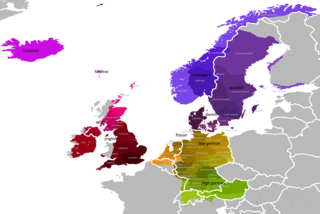
The Germanic languages are a branch of the Indo-European language family spoken natively by a population of about 515 million people mainly in Europe, North America, Oceania and Southern Africa. The most widely spoken Germanic language, English, is also the world's most widely spoken language with an estimated 2 billion speakers. All Germanic languages are derived from Proto-Germanic, spoken in Iron Age Scandinavia and Germany.
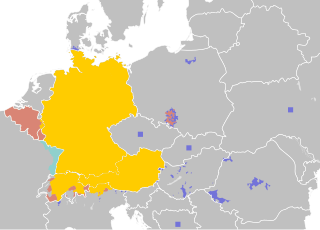
German is a West Germanic language mainly spoken in Western and Central Europe. It is the most widely spoken and official or co-official language in Germany, Austria, Switzerland, Liechtenstein, and the Italian province of South Tyrol. It is also an official language of Luxembourg and Belgium, as well as a recognized national language in Namibia. Outside Germany, it is also spoken by German communities in France (Alsace), Czech Republic, Poland, Slovakia, and Hungary (Sopron).
The High German languages, or simply High German – not to be confused with Standard High German which is commonly also called "High German" – comprise the varieties of German spoken south of the Benrath and Uerdingen isoglosses in central and southern Germany, Austria, Liechtenstein, Switzerland, Luxembourg, and eastern Belgium, as well as in neighbouring portions of France, Italy, the Czech Republic (Bohemia), and Poland. They are also spoken in diasporas in Romania, Russia, Canada, the United States, Brazil, Argentina, Mexico, Chile, and Namibia.

Old Norse, Old Nordic, or Old Scandinavian is a stage of development of North Germanic dialects before their final divergence into separate Nordic languages. Old Norse was spoken by inhabitants of Scandinavia and their overseas settlements and chronologically coincides with the Viking Age, the Christianization of Scandinavia and the consolidation of Scandinavian kingdoms from about the 8th to the 15th centuries.
Saxon language may refer to:
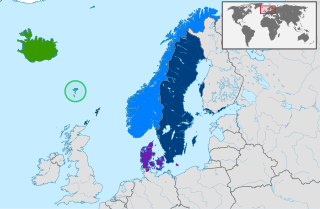
The North Germanic languages make up one of the three branches of the Germanic languages—a sub-family of the Indo-European languages—along with the West Germanic languages and the extinct East Germanic languages. The language group is also referred to as the Nordic languages, a direct translation of the most common term used among Danish, Faroese, Icelandic, Norwegian, and Swedish scholars and people.

The West Germanic languages constitute the largest of the three branches of the Germanic family of languages. The West Germanic branch is classically subdivided into three branches: Ingvaeonic, which includes English and Frisian; Istvaeonic, which encompasses Dutch and its close relatives; and Irminonic, which includes German and its close relatives and variants.
Northern Low Saxon is a subgroup of Low Saxon dialects of Low German. As such, it covers a great part of the West Low German-speaking areas of northern Germany, with the exception of the border regions where South Low Saxon is spoken, and Gronings dialect in the Netherlands.
A-mutation is a metaphonic process supposed to have taken place in late Proto-Germanic.

In historical linguistics, the High German consonant shift or second Germanic consonant shift is a phonological development that took place in the southern parts of the West Germanic dialect continuum in several phases. It probably began between the third and fifth centuries and was almost complete before the earliest written records in High German were produced in the eighth century. From Proto-Germanic, the resulting language, Old High German, can be neatly contrasted with the other continental West Germanic languages, which for the most part did not experience the shift, and with Old English, which remained completely unaffected.

The Anglo-Frisian languages are the Anglic and Frisian varieties of the West Germanic languages.

The appearance of the German language begins in the Early Middle Ages with the High German consonant shift. Old High German, Middle High German, and Early New High German span the duration of the Holy Roman Empire. The 19th and 20th centuries saw the rise of Standard German and a decrease of dialectal variety.

German dialects are the various traditional local varieties of the German language. Though varied by region, those of the southern half of Germany beneath the Benrath line are dominated by the geographical spread of the High German consonant shift, and the dialect continuum that connects German to the neighboring varieties of Low Franconian (Dutch) and Frisian.

Franconian or Frankish is a collective term traditionally used by linguists to refer to many West Germanic languages, some of which are spoken in what formed the historical core area of Francia during the Early Middle Ages.
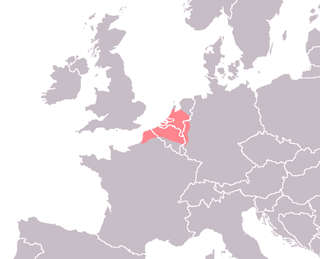
In linguistics, Old Dutch or Old Low Franconian is the set of Franconian dialects spoken in the Low Countries during the Early Middle Ages, from around the 6th or 9th to the 12th century. Old Dutch is mostly recorded on fragmentary relics, and words have been reconstructed from Middle Dutch and Old Dutch loanwords in French.

The languages of Scotland belong predominantly to the Germanic and Celtic language families. The classification of the Pictish language was once controversial, but it is now generally considered a Celtic language. Today, the main language spoken in Scotland is English, while Scots and Scottish Gaelic are minority languages. The dialect of English spoken in Scotland is referred to as Scottish English.
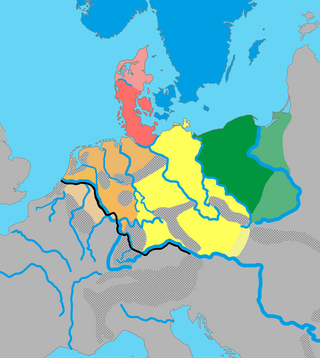
In historical linguistics, the Ingvaeonic nasal spirant law is a description of a phonological development that occurred in the Ingvaeonic dialects of the West Germanic languages. This includes Old English, Old Frisian, and Old Saxon, and to a lesser degree Old Dutch.
The following outline is provided as an overview of and topical guide to German language:












